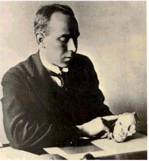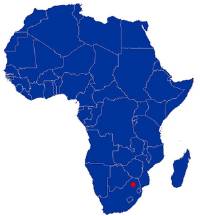Australopithecus africanus
Online Biology Dictionary
| A video about Australopithecus africanus |
|
|
EUGENE M. MCCARTHY, PHD
 A. africanus (Enlarge) head model - adult male - on display in the Hall of Human Origins in the Smithsonian Museum of Natural History in Washington, D.C. - 2012-05-17 (Image: Tim Evanson)
A. africanus (Enlarge) head model - adult male - on display in the Hall of Human Origins in the Smithsonian Museum of Natural History in Washington, D.C. - 2012-05-17 (Image: Tim Evanson) Raymond Dart with the Taung Child.
Raymond Dart with the Taung Child.
|
|
The Taung Child A. africanus  "Mrs. Ples"
"Mrs. Ples"Photo: Guérin Nicolas  Taung Child. Beak gouges?
Taung Child. Beak gouges?(enlarged image) Photo: Lee Berger 
|
| A. africanus is known only from South Africa |
The first Australopithecus africanus specimen — or australopithecine of any kind — ever discovered was the Taung Child, (sometimes called the "Taung Baby" — the individual in question was three-and-a-half years old) of which the facial portion of the skull is well-preserved (see image below right and the video at the top of this page). It was found in a box of rocks from a cave at Taung, South Africa by anatomist Raymond Dart of the University of the Witwatersrand in Johannesburg. He at first could see only a brain cast protruding from a chunk of stone, but he saw immediately that a primate was in question, and painstakingly chipped the embedded face free of the rock matrix.
Dart (1925) immediately claimed the specimen represented a very early human ancestor. The scientific establishment, however, long rejected his claim. Accepted wisdom at the time said humans had come into being in Asia.
The most complete skull of an Australopithecus africanus adult ever found (dating to 2.15 mya), a specimen (STS 5) nicknamed "Mrs. Ples"† (see image at right), was discovered in 1947 by Dart’s friend, Robert Broom and John T. Robinson at Sterkfontein. Ples is short for Plesianthropus, the defunct genus to which the skull was originally assigned. Many additional A. africanus fossils continue to be found at Sterkfontein (see picture of excavation), but no others have ever been found at Taung, despite intensive search.
In a recent paper (Berger 2006), paleontologist Lee Berger provides strong evidence that marks in the eye sockets of the Taung Child are damage caused by birds of prey. The study shows it’s likely that an eagle brought the child to the site where the skull was discovered, and that this is the reason for the absence of other australopithecine remains at Taung. The marks that have been interpreted as beak damage caused when eagles ripped out the unfortunate child’s eyes are indicated in the figure at left.
Similar to its northern precursor, Australopithecus afarensis, which is known from east Africa, Australopithecus africanus was bipedal with arms a bit longer than its legs. Both were gracile australopithecines with relatively slender builds.
Australopithecus africanus had a cranial capacity of about 450 cc, a brain size that puts it on a par with a rather brainy modern chimpanzee.
Experts who argue Australopithecus africanus was an ancestor of modern humans say it was somewhat more human-like with respect to cranial characteristics than was Australopithecus afarensis. However, it also had apelike traits such as curved fingers suited for climbing trees. Such simian features suggest to some researchers that A. africanus evolved into Paranthropus robustus, one of the robust autralopithecines, not Homo.However — whether the facts are consistent with the idea that australopithecines were direct ancestors of humans or not — Raymond Dart’s work, together with that of Robert Broom and the Leakeys, succeeded in convincing the scientific world that Darwin had been right in asserting humankind had its origins in Africa.
The focus remains on that continent today, though the exact role of the australopithecines in human evolution has yet to be resolved.
|
Perhaps we are not from the apes alone? Learn more >> 
|
|
Habitat: Savanna-forest mosaic. Synonym: Plesianthropus transvaalensis. Etymology: The name of this hominid is constructed from the Latin prefix australo-, the Greek suffix -pithecus, and the Latin word africanus meaning from or of Africa. Note: The skull of the Taung Child is strikingly similar to skulls attributed to the far more recent Homo floresiensis. Work cited: Dart, R. A. 1925. Australopithecus africanus: the man-ape of South Africa. Nature, 115: 195-199. (793 Kb download of Dart’s first report of the discovery of the Taung skull) |
Interesting facts about other members of genus Homo:
Australopithecus bahrelghazali >>
Most shared on Macroevolution.net:
Human Origins: Are we hybrids?
On the Origins of New Forms of Life
Mammalian Hybrids
Cat-rabbit Hybrids: Fact or fiction?
Famous Biologists
Dog-cow Hybrids
Georges Cuvier: A Biography
Prothero: A Rebuttal
Branches of Biology
Dog-fox Hybrids